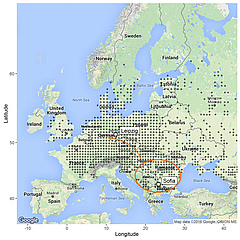21.10.2016 | Research, TOP NEWS
Life on the edge is dangerous

Sand lizards (Lacerta agilis) prefer relatively open landscapes with individual trees and shrubs. Photo: Annegret Grimm-Seyfarth / UFZ

The range of the sand lizard reaches from France to Lake Baikal and from Sweden to the Balkans. The researchers investigated populations on the edge (Sofia region) and in the middle (Leipzig region). Photo: Google 2016, ORION-ME, Editing: UFZ
Note for the media: Use of the pictures provided by iDiv is permitted for reports related to this media release only, and under the condition that credit is given to the picture originator.
Klaus Henle, Claudia Andres, Detlef Bernhard, Annegret Grimm, Pavel Stoev, Nikolay Tzankov, Martin Schlegel (2016): Are species genetically more sensitive to habitat fragmentation on the periphery of their range compared to the core? A case study on the sand lizard (Lacerta agilis); Landscape Ecology, online edition
http://link.springer.com/article/10.1007/s10980-016-0418-2
